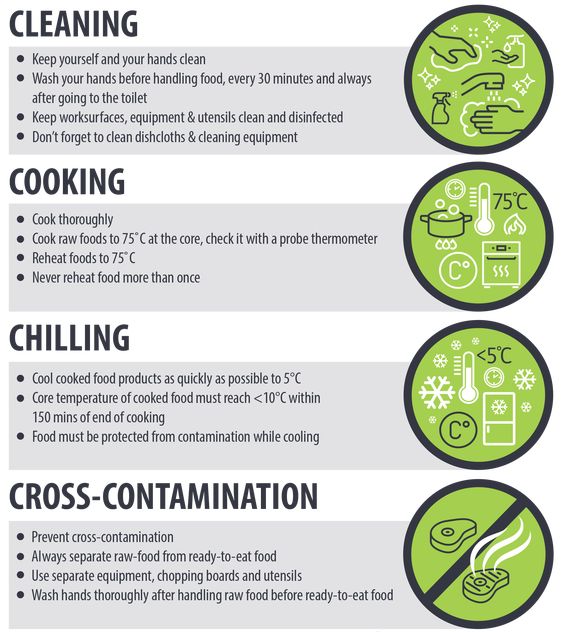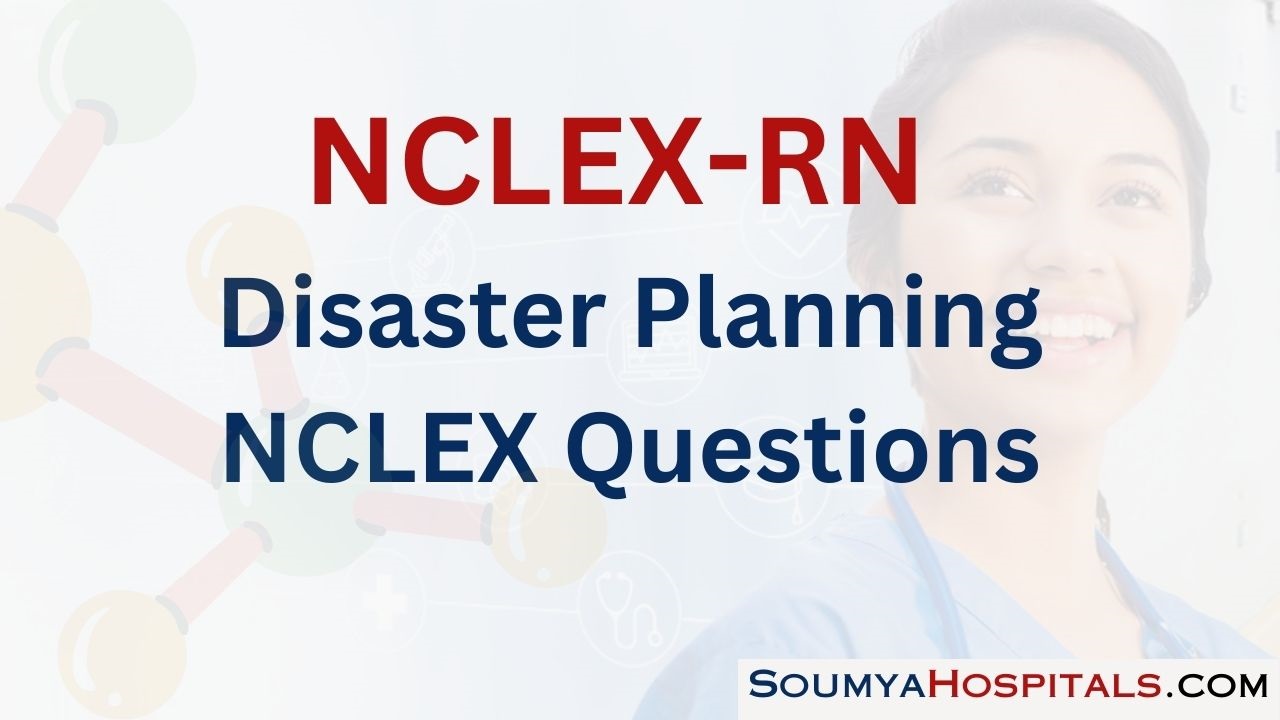NCLEX Prep Questions provide a simulated testing environment that helps students become familiar with the format and style of the actual exam.
NCLEX Disaster Planning Questions - NCLEX Questions on Disaster Planning
Disaster Planning NCLEX Questions Test Strategies
Before practice section, let's remember some important points for acing questions of this section:
- FEMA categorizes disasters into three levels: Level 1, Level 2, and Level 3.
- In Level 1 disasters, the President declares the disaster and there is full federal involvement and support.
- In Level 2 disasters, there is moderate federal involvement or support and it may also start with a presidential emergency declaration.
- In Level 3 disasters, there is a minor disaster and small federal support.
- Nurses play a significant role in disaster response at all levels, and their responsibilities include being prepared for emergency drills, training in disaster management and CPR, making personal and professional preparations, and familiarizing themselves with the disaster management plan at their hospital.
- Mitigation is the first phase of disaster management, and it involves any actions taken to reduce the damage caused by the disaster.
- Preparedness is the second phase, and it involves planning and being ready in case a disaster occurs.
- Some preparedness activities include mock drills, emergency plans, disaster management plans, and forming a disaster- response group.
- Response is the third phase, and it involves taking actions to save people's lives.
- Recovery is the fourth and final phase, and it involves restoring the situation to its condition prior to the disaster.
Disaster Planning NCLEX Practice Questions
Question 1.
A category 4 hurricane is expected to hit a coastal town in the United States. The local government has issued a mandatory evacuation order for residents living in low-lying areas. As a nurse working in a hospital in the area, what would be your role in the disaster response?
(a) Assist in the evacuation process and provide first aid to those in need.
(b) Stay in the hospital and provide medical care to patients.
(c) Go home and prepare your own family for the hurricane.
(d) Wait for further instructions from hospital management.
Answer:
(a) Assist in the evacuation process and provide first aid to those in need.
Explanation:
As a nurse, your role in a disaster response would involve being prepared for emergency drills, train in disaster management and CPR. and making personal, professional, and family preparations. In this scenario, a category' 4 hurricane is expected to hit, and a mandatory evacuation order has been issued. As a nurse, your primary responsibility would be to assist in the evacuation process and provide first aid to those in need. This would involve helping patients and their families evacuate the hospital and providing medical care to those who may require it during the evacuation process.
Option (b) staying in the hospital and providing medical care to patients would not be feasible as the hospital would also be evacuated.
Option (c) going home and preparing your own family is important but not the priority at the moment.
Option (d) waiting for further instructions from hospital management is not appropriate as immediate action is required in a disaster situation.
Question 2.
A regional flood occurs in a small town in the United States. The president declares it as a disaster and provides small federal support.
What type of disaster does this fall under according to the FEMA levels of disaster response?
(a) Level 1 Disaster
(b) Level 2 Disaster
(c) Level 3 Disaster
(d) Level 0 Disaster
Answer:
(c) Level 3 Disaster
Explanation:
According to the information provided, the president declares the disaster and there is small federal support. This aligns with the definition of a Level 3 Disaster, wflich is a minor disaster with small federal support.
Option (a) Level 1 Disaster is incorrect because it is described as a full federal involvement and support, wrhich is not the case in this scenario.
Option (b) Level 2 Disaster is also incorrect because it is described as moderate federal involvement or support, which is not the case in this scenario.
Option (d) Level 0 Disaster is incorrect because it is not a recognized level of disaster response by FEMA.

Question 3.
A severe earthquake has hit a city causing widespread destruction. The local authorities have activated their disaster management plan. Identify the correct phase of disaster management that the authorities are currently in.
(a) Mitigation
(b) Preparedness
(c) Response
(d) Recovery
Answer:
(c) Response
Explanation:
The correct phase of disaster management that the authorities are currently in is the response phase. During this phase, the focus is on saving people's lives and taking necessary actions to ensure their safety. The response phase starts immediately after the disaster has occurred and continues until the situation is under control.
Option (a) Mitigation: Mitigation involves actions taken to reduce the impact of a disaster before it occurs. In the case of an earthquake, mitigation actions could include strengthening buildings, constructing earthquake-resistant structures, and identifying potential hazards.
Option (b) Preparedness: Preparedness involves planning and preparing for a disaster before it occurs. Activities in this phase could include conducting mock drills, developing emergency plans, and allocating resources and personnel.
Option (d) Recovery: The recovery phase involves restoring the community to its pre-disaster state. This phase can include activities such as repairing infrastructure, providing medical care, and distributing aid to affected individuals and families.
In summary, the correct answer is (c) Response because during this phase, the focus is on taking necessary actions to save people's lives and bring the situation under control. Mitigation involves actions taken to reduce the impact of a disaster before it occurs, preparedness involves planning and preparing for a disaster, and recovery involves restoring the community to its pre-disaster state.
Question 4.
A healthcare organization is undergoing a major restructuring, and the nursing department is one of the areas that will be affected. The current nursing manager, who has been with the organization for many years, is known for being a strict leader who relies heavily on rewards and punishments to manage her team. The employees have expressed dissatisfaction with her leadership style and have requested for a change.
The organization decides to promote one of the experienced nurses to the position of nursing manager and provide her with leadership training. She is taught about the different leadership styles. This includes focusing on meeting the needs of her team members, encouraging participation and input, and promoting a sense of collaboration and collective ownership among the staff.
Which leadership style is most likely to be effective in this case scenario?
(a) Charismatic leadership
(b) Transactional leadership
(c) Servant leadership
(d) Quantum leadership
Answer:
(c) Servant leadership
Explanation:
(a) Charismatic leadership: This type of leadership is characterized by the leader being seen as a heroic figure by the followers. While this may be effective in some situations, it may not be the best approach for a leader in a healthcare organization who is trying to restructure a department and promote a sense of col laboration and collective ownership among the staff.
(b) Transactional leadership: This type of leadership relies heavily on rewards and punishments to manage the team. The current nursing manager's leadership style is based on this approach and it has been ineffective, so this type of leadership is not the best option.
(c) Servant leadership: This type of leadership focuses on meeting the needs of the team members, encouraging participation and input, and promoting a sense of collaboration and collective ownership among the staff. This approach aligns well with the goals of the organization and the staffs, therefore it is most likely to be effective in this case scenario.
(d) Quantum leadership: This type of leadership is characterized by leaders thinking ahead and encouraging questions and experiments. While this may be effective in some industries, it may not be the most appropriate approach for a leader in a healthcare organization who is trying to restructure a department and promote a sense of collaboration and collective ownership among the staff.
Question 5.
A new team leader has been appointed in charge of a department of a hospital. The department is responsible for the care of patients suffering from chronic illnesses. The team leader is tasked with improving the productivity and morale of the department staff.
Which type of leadership style would be most appropriate for the new team leader to adopt in this situation?
(a) Servant leadership
(b) Quantum leadership
(c) Charismatic leadership
(d) Transactional leadership
Answer:
(a) Servant leadership
Explanation:
Servant leadership would be the most appropriate leadership style for the new team leader to adopt in this situation. Servant leaders prioritize the needs of the team members and work to facilitate their growth and development. In a healthcare setting, this could include providing training and resources, mentoring, and creating a positive work environment. This approach would be beneficial to improve the productivity and morale of the department staff.
(b) Quantum leadership is not appropriate in this situation because this approach is highly creative and experimental and more suitable for a high-tech or R&D department.
(c) Charismatic leadership is not appropriate in this situation because this leadership style is more about inspiring followers through charm and personality rather than through practical support. In a healthcare setting, the focus should be on providing patients with quality care, which requires a more hands-on approach.
(d) Transactional leadership is not appropriate in this situation because this approach relies on rewards and punishment to achieve optimal job performance, which may not be the best way to improve productivity and morale in a healthcare setting.
In general, in a healthcare setting, the Servant Leadership style is often the most appropriate as it focuses on team members' and staff's needs, thus providing them with a positive work environment which would be beneficial to provide the best care to patients.
Also Read:
